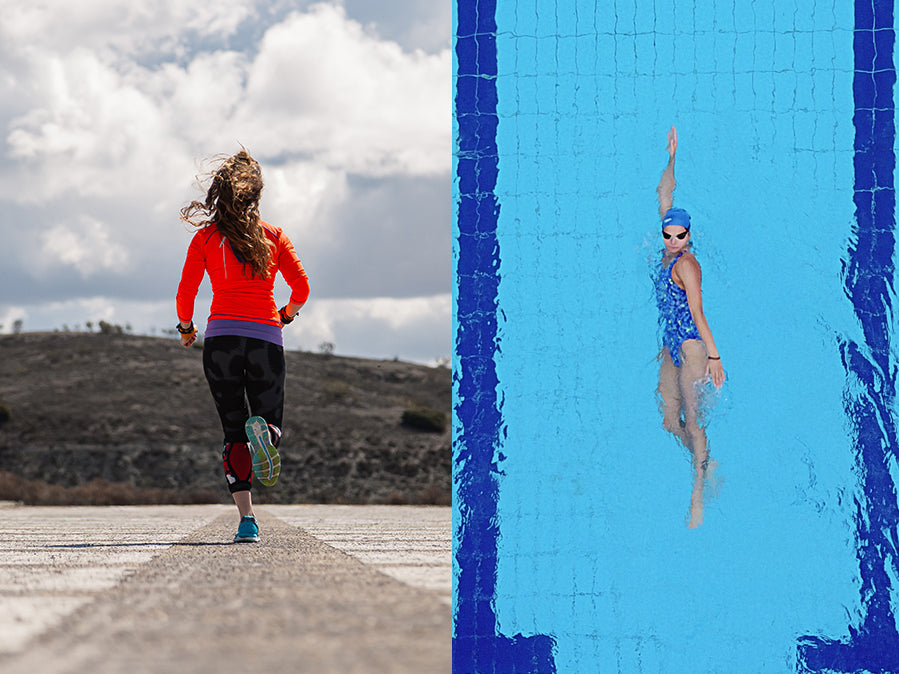Swimming or Running: Which is Better for Fitness?
It’s important to find the right type of physical activity for you; not only to achieve your fitness goals, but to promote overall health and wellness. With endless options to choose from (cycling, hiking, rock climbing, etc.), two forms of aerobic exercise continue to remain popular among serious fitness aficionados and beginners alike: running and swimming.
The question is, which is better for fitness?
It truly depends on your personal fitness level and goals; whether that’s to improve your conditioning or fitness level, lose weight, improve cardiovascular health, burn calories, gain muscle, or improve bone density.
If you’re recovering from an injury, swimming is a common recommendation for exercise that’s easier on your joints. But recovery isn’t the only reason to hop in the pool! Swimming has several health benefits, as well as some advantages over running for fitness.
Do you burn more calories swimming or running?
There are different opinions when it comes to burning calories while swimming or running. Most agree that swimming is a more effective way to burn more calories.
Does swimming burn calories? To burn calories, you need to strive for high intensity swimming, which keeps your heart rate at 70-85% of maximum. Because the resistance of water is so much higher (and more consistent) than air, it’s easier to burn calories while swimming.
Simply put, you’ll burn more calories swimming compared to running the same distance. Swimming is a full body workout, which results in more calories burned.
When it comes to running, you must maintain a certain speed and consistent cardiovascular exertion to burn comparable calories. According to Harvard Health, running can burn calories like swimming, but it depends on your body weight. For example, a 125-pound person will burn about 180 calories in 30 minutes of swimming, while a 155-pound person will burn about 216 calories in the same amount of time. Try to focus on shorter, faster runs instead of long distance to reduce joint strain.
Is swimming or running better for weight loss?
While swimming is better than running for calorie burn, they share the same benefits when it comes to losing weight.
Is swimming better than running? Some argue swimming is better since it works more muscle groups in your upper body at a greater resistance. But it depends on the intensity and length of your workout.
Studies have shown that high-intensity interval training (HIIT) is a better workout than a longer, moderate workout. In thirty minutes, you can gain the benefits of an hour of cardio by exercising vigorously with short, low intensity breaks. You can do this while running or swimming, as long as you stay consistent at each interval.
Is swimming better than running for cardio?
Swimming is better than running for cardiovascular exercise because there is greater resistance in water than in the air.
Both are forms of aerobic exercise (increasing your heart rate and promoting better cardiovascular health), but it takes more effort to kick in water than to take a step while running. Because of this, swimming can be considered as resistance training.
Is swimming or running better for muscle gain?
Being a full body activity, swimming requires more muscle groups, whereas running focuses on lower body muscles (abs and legs).
When done correctly, freestyle (a.k.a. front crawl) engages your upper body muscles, particularly your shoulders and arms. Swimming is a great way to gain lean muscle mass with minimal pressure to your bones and joints, so you can remain active in the long term.
Which is better for bone strength?
Running helps with bone health because it’s a weight bearing exercise, which helps improve bone density.
Unlike running, swimming is a low impact exercise—often recommended for people recovering from injuries. Determining the right form of physical activity depends on your physical fitness needs, including those regarding joint health.
Cold weather: swimming vs running
When the weather gets colder, it can be hard to stay motivated and just keep swimming or exercising in general, Luckily, swimming and running have proven benefits when done in cooler temperatures.

Running in the cold might sound daunting (or like a nightmare), but if you’re dressed appropriately, it can be a great way to get some Vitamin D. One study found that cooler temperatures increased participants’ brown fat (which burns calories) instead of white fat (which stores calories), with subsequent changes in metabolism. Running in cold weather is also easier on your body since there’s less heat stress. It also promotes a faster metabolism before your body gets into a winter rhythm of moving less and eating more.
Cold swimming comes with its own (arguably more exciting) list of health benefits. Cold water has been proven to increase your number of white blood cells, strengthening your immune system. It also improves your blood circulation, as it flushes to your extremities to keep you warm. Repeated cold-water swimming will get easier as your body’s circulatory system adapts. Studies have also shown that cold water swimming reduces stress, improves memory retention, and can give you a swimming high. Like running, cold swimming promotes weight loss more than in regular temperatures.
Swimming vs Running: Risk of Injury
As mentioned, swimming is the best option if you suffer from joint pain because its lower impact compared to running.
When running, most injuries can be prevented, but a list of common ones includes shin pain, blisters, soft tissue injuries (ligaments, stretched muscles), and skin injuries (bruises, scrapes). Of course, there are increased risks of injury if you overexert yourself or have poor running form. Running on concrete can increase stress fractures, leading to joint problems. To maintain better joint health, try to balance running with low impact exercise, like swimming.
Swimming puts less pressure on your joints than running, but still comes with its own risks. Swimmers often experience pain in their shoulders and neck, including tendonitis or ligament damage from overexertion. You may also experience pain in your wrists and rotator cuff from the repetitive movements that come with different swimming strokes.
Mental health benefits
The benefits of swimming and running are similar in terms of mental health. They both release endorphins and serotonin (the happy hormones), which reduce pain and stress.
Then there’s the runner’s high: a euphoric feeling that comes after a long run when endocannabinoids (another type of chemical) are released and travel to your brain. You can experience the same high as a swimmer; it’s simply about how long and hard you exercise. Not everyone will experience the runner or swimmer high, but you will have reduced anxiety, stress, and pain.
Both happy hormones promote better mental health (with serotonin deficiencies being linked to depression). In fact, people who exercise regularly experience less fatigue and are more productive at work, and generally are more satisfied.
Ease of access
Running does have an advantage over swimming here in that you can run anywhere, anytime. Running is the way to go if you’re on the go, there’s no denying that! You can bring a change of clothes or shoes with you and easily fit in a run during your day.
To get in a good swim, you’ll have to do a little more to plan. Try your local indoor pools or open water swimming (depending on the weather and season) to see what fits best with your schedule and lifestyle.
What equipment do I need?
Swimming and running both have simple required equipment and the opportunity to get technical and data-oriented in your workouts—a balance we love at FORM.
For swimming, your first piece of equipment should be a quality swimsuit that is tight enough to conform to your body and reduce drag in the water. A swim cap is also helpful to keep hair out of your face and water out of your ears.
For swimmers, a good set of goggles is also essential; take it a step further with the Smart Swim Goggles and track your performance metrics. The Smart Display allows you to monitor your split time, interval time, stroke rate. and heart rate. At the end of your swim, you can review even more metrics like total distance, distance per stroke, and stroke count by syncing your goggles to your phone via Bluetooth. Our goggles can provide insight into your fitness goals as well, as they track your heart rate and calories burned. Whether you’re aiming to lose weight, gain muscle or burn calories, you can track your progress as you swim.

If it wasn’t obvious, you also need to find a pool to swim at! You can also opt for open water swimming, just make sure you stay safe and check the weather first. If you’re diving in for a cold-water swim, consider heat retention gear like a swimming hat and wetsuit.
For runners, there is no shortage of workout gear available—the essentials are breathable clothes and supportive shoes. Depending on the season and terrain, you may want to consider shoes and clothing to match the occasion. During the warmer months, a t-shirt and shorts should be enough, but you’ll want to layer up as the weather gets colder.
The best shoes for running on a treadmill are usually not the same as those for trails or paths. Consider the cushioning under the sole, the shoe tread (rough terrain = deeper tread), and waterproofing. There are different types of shoes to consider; traditional running shoes, which support shock to the ankles, and cross-training shoes which have more cushioning in the toes (for jumping, lifting weights, etc.). We also recommend bringing a water bottle, especially if you’re running in hot weather.
So, should you swim or run?
Ultimately, the decision is yours depending on your fitness level, resources, and goals.
Choose swimming if you experience joint pain or prioritize muscle gain and burning calories. Running is great for getting outside, building bone density, and finding a runner’s high.
The most important takeaway is to adopt healthy habits that include regular aerobic exercise. Your overall health is made up of exercise, diet, sleep, and many extenuating circumstances. A good workout can do a lot for your health, as long as you practice injury prevention, exercise consistently, and maintain your personal nutrition. Whether you add swimming or running into your fitness routine, we recommend keeping track of your progress to stay motivated and have fun with it!










